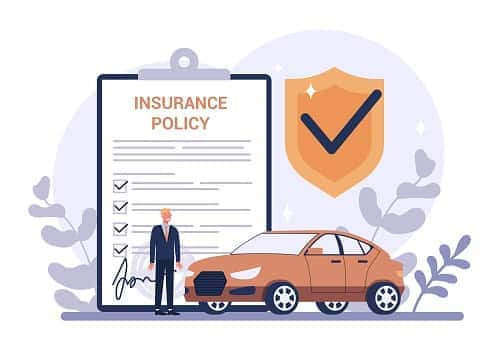- Who needs a high-risk insurance policy?
- What is the best insurance company for high-risk drivers?
- What is the cheapest car insurance for high-risk drivers?
- Average cost of high-risk car insurance by state
- How to save money on high-risk auto insurance
- How to shop for high-risk car insurance
- Auto insurance FAQs
Who needs a high-risk insurance policy?
As mentioned before, high-risk car insurance is for drivers who are considered riskier to an insurer than your average driver. While young drivers represent a higher risk to insurance companies than older drivers, they usually don't require a high-risk insurance policy and can be insured on a standard policy, albeit at higher rates.
So what exactly is a high-risk driver? Here are some groups of drivers that are typically deemed as high-risk drivers, and potentially need to apply for a high-risk insurance policy:
Drivers with multiple tickets or accidents on their record: A single ticket or minor fender bender might not make you high-risk, but multiple tickets will. So will multiple at-fault claims.
Drivers convicted of a serious violation. A DUI, reckless driving or other serious violation can immediately land you in the high-risk category. These could also require you to get an SR-22, which is a state-mandated certificate that indicates you carry a policy that meets the state's minimum insurance coverage requirements.
Drivers who have been caught driving uninsured: If you have been caught driving uninsured, insurance companies see you as riskier to insure in the future. While it doesn't always mean you won't qualify for standard iinsurance
Drivers with bad credit: Drivers with poor credit-based insurance scores tend to file more frequent claims. As a result, they may be categorized as high-risk. A handful of states have outlawed the use of credit in car insurance rating.
Is a teenager a high-risk driver? Yes and no. Teens are among the highest risk category, and as a result they pay a lot more for insurance. However, they aren't required to apply for a high-risk policy unless there's something other than age at play, like tickets or accidents.
What is the best insurance company for high-risk drivers?
As a high-risk driver, you may be able to buy a standard policy at a higher rate from a traditional private insurance company. Or you may have to buy a non-standard policy from a company that specializes in insuring high-risk drivers.
The good news is that there are some big companies, like Progressive and Nationwide, that have divisions selling nonstandard policies. There are also smaller non-standard companies that are reputable as well.
Bear in mind that there's a difference between paying more for a policy from a standard insurance company due to your driving record and needing a high-risk insurance policy.
Based on a survey and study of rates by Insure.com, our sister site, Insurance.com's best car insurance companies for 2023 ranks Allstate as the best car insurance company among major insurers for high-risk drivers.
What is the cheapest car insurance for high-risk drivers?
The cheapest car insurance company for high-risk drivers really depends on the reason you are considered high-risk.
The cheapest company for drivers with a DUI, based on Insurance.com's 2022 rates, is American Family, with an average annual rate for full coverage of $2,521 a year. That's unless you are a military member or veteran, in which case you'll get a better deal from USAA.
However, if you have multiple tickets or a accidents, a combination of both, or are high-risk for another reason, the cheapest company for you will vary. The best thing to do is to shop around and compare car insurance rates from as many companies as possible to find the best deal.
Average cost of high-risk car insurance by state
The cost of car insurance varies by state, and that's true for high-risk drivers as well. Below are some average rates for a variety of issues that could affect your car insurance rates.
| State | Average rate | DUI rate | 2 Speeding tickets | 1 accident with injuries | Poor credit |
|---|---|---|---|---|---|
| Alabama | $1,217 | $2,029 | $1,533 | $1,482 | $2,184 |
| Alaska | $1,188 | $1,771 | $1,405 | $1,313 | $1,705 |
| Arizona | $1,009 | $2,532 | $1,245 | $1,301 | $1,761 |
| Arkansas | $1,277 | $2,087 | $1,535 | $1,475 | $1,823 |
| California | $1,461 | $3,765 | $2,878 | $2,769 | $1,461 |
| Colorado | $1,095 | $1,660 | $1,457 | $1,363 | $1,784 |
| Connecticut | $1,597 | $2,592 | $2,026 | $1,979 | $2,351 |
| DC | $1,628 | $2,406 | $1,965 | $1,971 | $2,711 |
| Delaware | $1,538 | $3,113 | $2,051 | $2,479 | $2,532 |
| Florida | $1,463 | $2,739 | $2,107 | $2,036 | $2,616 |
| Georgia | $1,210 | $1,972 | $1,516 | $1,655 | $2,053 |
| Hawaii | $1,104 | $3,112 | $1,531 | $1,196 | $1,104 |
| Idaho | $822 | $1,279 | $1,338 | $1,130 | $1,361 |
| Illinois | $990 | $1,570 | $1,230 | $1,278 | $1,652 |
| Indiana | $950 | $1,651 | $1,213 | $1,199 | $1,546 |
| Iowa | $939 | $1,345 | $1,247 | $1,255 | $1,294 |
| Kansas | $1,141 | $1,816 | $1,559 | $1,486 | $1,783 |
| Kentucky | $1,177 | $2,176 | $1,514 | $1,436 | $2,228 |
| Louisiana | $1,645 | $2,488 | $1,902 | $2,064 | $2,719 |
| Maine | $758 | $1,386 | $1,011 | $982 | $1,233 |
| Maryland | $1,260 | $1,411 | $1,606 | $1,425 | $2,022 |
| Massachusetts | $1,469 | $2,629 | $2,213 | $2,420 | $1,469 |
| Michigan | $2,297 | $6,337 | $5,306 | $3,057 | $5,078 |
| Minnesota | $1,270 | $2,584 | $1,829 | $1,695 | $2,151 |
| Mississippi | $1,218 | $1,913 | $1,499 | $1,385 | $1,667 |
| Missouri | $1,039 | $1,550 | $1,580 | $1,228 | $3,593 |
| Montana | $1,321 | $2,249 | $1,724 | $1,597 | $2,079 |
| National | $1,215 | $2,146 | $1,673 | $1,571 | $1,986 |
| Nebraska | $1,035 | $1,759 | $1,346 | $1,211 | $1,666 |
| Nevada | $1,113 | $1,696 | $1,387 | $1,389 | $2,182 |
| New Hampshire | $865 | $1,776 | $1,282 | $1,140 | $1,637 |
| New Jersey | $1,348 | $2,499 | $1,949 | $1,728 | $2,001 |
| New Mexico | $1,125 | $1,787 | $1,353 | $1,358 | $1,718 |
| New York | $1,336 | $2,144 | $1,613 | $1,699 | $2,414 |
| North Carolina | $836 | $3,206 | $1,491 | $1,161 | $1,025 |
| North Dakota | $1,365 | $2,143 | $2,063 | $1,553 | $1,864 |
| Ohio | $763 | $1,165 | $985 | $912 | $1,293 |
| Oklahoma | $1,405 | $2,461 | $2,542 | $1,821 | $3,236 |
| Oregon | $1,110 | $1,737 | $1,393 | $1,409 | $1,925 |
| Pennsylvania | $1,252 | $1,968 | $1,676 | $1,577 | $2,042 |
| Rhode Island | $2,117 | $3,502 | $2,710 | $2,724 | $2,847 |
| South Carolina | $1,055 | $1,566 | $1,234 | $1,362 | $1,759 |
| South Dakota | $1,080 | $1,520 | $1,396 | $1,530 | $1,715 |
| Tennessee | $1,256 | $2,193 | $1,573 | $1,580 | $1,895 |
| Texas | $1,416 | $2,267 | $1,923 | $1,956 | $2,247 |
| Utah | $935 | $1,472 | $1,184 | $1,284 | $1,633 |
| Vermont | $900 | $1,392 | $1,107 | $1,031 | $1,517 |
| Virginia | $849 | $1,415 | $1,203 | $1,053 | $1,452 |
| Washington | $1,075 | $1,740 | $1,395 | $1,496 | $1,702 |
| West Virginia | $1,534 | $2,523 | $1,841 | $1,827 | $2,344 |
| Wisconsin | $863 | $1,417 | $1,164 | $1,171 | $1,342 |
| Wyoming | $1,237 | $1,945 | $1,498 | $1,501 | $1,878 |
How to save money on high-risk auto insurance
While the cost of car insurance for high-risk drivers can be steep, you can still find ways to save. Here are a few ways anyone, including high-risk drivers, can lower their rates:
- Shop around
- Take a defensive driving course
- Raise your deductible
- Bundle your auto and homeowners insurance
- Improve your credit score
- Have a multi-car policy
- Ask about low-mileage discounts if you don’t drive much
- Drive cautiously, so you build a clean driving record
- Ask the insurance company about all available discounts
How to shop for high-risk car insurance
Comparison shop. Compare quotes from both standard (if you qualify) and non-standard companies. Get quotes based on different coverage amounts to compare, but be careful that you aren't underinsured.
Look closely at rates. Get quotes for the same coverage amounts for each of the insurers. Otherwise, you'll be comparing apples to oranges. Also, it's important to remember that the rates for high-risk insurance can vary depending on why you're considered high risk.
Ask about discounts. Discounts are usually available to all drivers, with the exception of those like the good driver discount. Ask what you qualify for, and remember that discounts vary by company.
Shop frequently. Rates might change among insurers. It's a good idea to comparison shop for high-risk car insurance every six months or so.
Auto insurance FAQs
How much is high-risk car insurance?
High-risk car insurance can be significantly more than standard car insurance. While it is more expensive overall, the cost can vary widely and depends on the insurer, where you live, and why exactly you are deemed high risk.
How can I lower my car insurance as a high-risk driver?
There are a number of ways you can bump down the cost of your car insurance when you are a high-risk driver. Your deductible can also impact your premium. The higher the deductible, the lower your premium, and vice versa.
Also, look for discounts an insurer might offer. This might be available if you are a loyal customer, go claim-free for a stint of time, for multi-vehicle insurance policies, and set up autopay. Some insurers also offer a discount if you sign up for a defensive driver course, or if you're a good student. When in doubt, do your homework and don't be afraid to ask to see what discounts are available.
What if I can’t find high-risk insurance?
Finding high-risk insurance can certainly be a tough task. You might find yourself knocking on many doors, with none of them opening. If one insurer declines you for auto insurance coverage, keep shopping with the best auto insurers. Compare quotes. By being informed and knowing what to expect in terms of rates and a policy, you can find a policy that works for you.
If you can't find insurance on the open market, you may have to buy a policy from your state's assigned risk pool - this is a service available in all states to ensure everyone can meet insurance requirements.
How long will I be considered a high-risk driver?
While three years is the typical timeframe, it depends on the particular insurance company and the state you live in. Some states and insurers will look back as far as five years. If an offense drops off your record, an insurer can use that to bump up your rates.
A lot of states use a points system. It works like so: you'll receive a score based on how severe an incident is. There are different points depending on the claims, accidents, and claims. But unlike many video games, where the more points you receive, the better, the more severe the offense, the greater the number of points.





